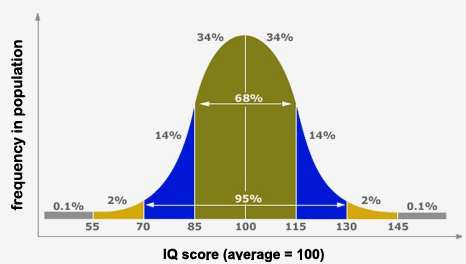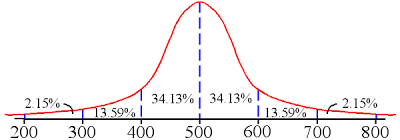Beware of the 100 point guarantee.
SAT scores are curved and not all problems are worth the same amount in the final scaled score even though they are worth the same in the raw score.
Imagine taking a test with 10 questions at school. If you get one wrong your grade is a 90% and if you get 9 wrong your grade is a 10%. It does not matter where you score with respect to the class average. Every problem is worth the same 10% and so all of the class scores are linear. This is NOT how the SAT works.
I am going to show you how moving 100 points in the Math section is radically different depending on the where student scores on a bell curve (similar to the IQ bell curve) by comparing raw and scaled scores.
Below is a list of raw Math scores and their corresponding scaled scores. Please note how the Difference in Raw Points changes to gain another 100 points along the way from a 200 to an 800. Remember raw scores are calculated by giving 1 raw point for each correct answer and subtracting ¼ raw point for each wrong answer on every multiple choice question. For more on Raw scores please reference Scaled SAT Math scores and Raw Scores.
|
Math Scaled Scores |
Math Raw Score |
Difference in Raw Points |
|
200 |
||
|
300 |
5 |
5 |
|
400 |
13 |
8 |
|
500 |
25 |
12 |
|
600 |
37 |
12 |
|
700 |
48 |
11 |
|
800 |
53-54 |
5-6 |
While the requisite raw score for a given scaled score may change slightly on any given date due to the curve, it does not change much since the sample group of students taking the test is so large.
According to ETS, over 2.5 million students take the test across seven different test dates annually.
For simplicity, we can assume an even distribution of test takers (which of course is not the case) to find that 357,000 students take the test each time it is administered. That is a huge sample group, the type that assures miniscule deviation and that any insurance underwriter would covet.
So now that we have gotten through all of the rough numbers, what do they mean? Simply put, the further away from the national average score of 500, the fewer raw points it takes to drastically change a scaled score.
This is important to know so you can understand how far away you actually are from your goals. Climbing from a 400 to a 600 is a lot of work. 24 more raw points is a considerable task when there are only 54 available raw points in the Math section. This is much harder than getting from 600 to an 800, only 16 raw points away. It makes me wonder how any company can blindly guarantee 100 point gain in a subject with out knowing where a student sits on the curve. But seeing what most companies offer as compensation is laughable and somewhat insulting. Please do your research. Ask questions before you commit your time and resources and beware of gimmicks and imitators.


